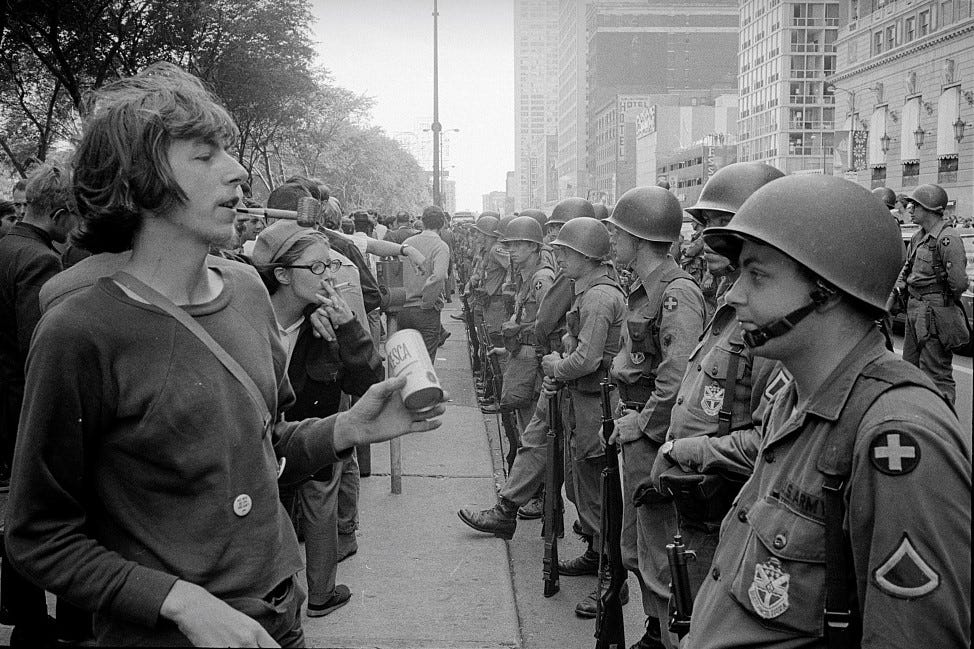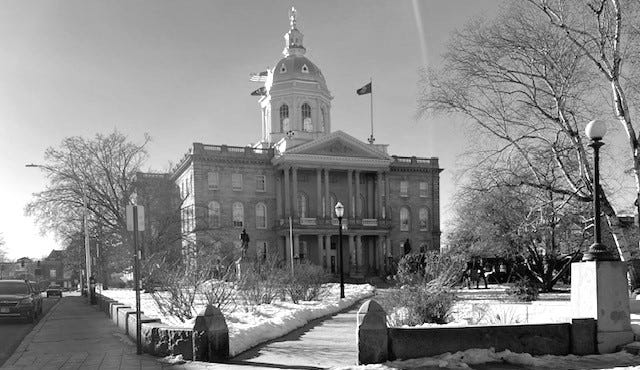Three Primaries
A series of granite plaques near the New Hampshire State House takes us back to three of the defining moments in presidential primary history.
Welcome or welcome back to History Buzz! If you’re a subscriber to the Buzz, thank you! If you’re new here, or you haven’t become a subscriber yet, please sign up for a subscription to have History Buzz delivered directly to your inbox. If you can, please consider a paid subscription to support the research and writing that make History Buzz possible.
Located outside of the state library, across from the State House, in Concord, New Hampshire, is a pathway of granite plaques. This pathway grows outward in a chronological line from the foot of a historical marker about the first-in-the-nation primary status of the state. Each step is engraved with the Democratic and Republican winners of New Hampshire primaries since 1952.
Selecting a party's presidential nominee in the United States is a process that had several big changes during the 20th century. New Hampshire has long held first-in-the-nation status for presidential primaries. That status, for the Democratic party primary, is being challenged. For now, we'll look at three of the defining moments in presidential primary history, and their granite plaques as steps in that history.

1952: The Progressive Era of Primaries
NH primary winners: Estes Kefauver (D) and Dwight D. Eisenhower (R)
National candidates: Adlai Stevenson II (D) and Dwight D. Eisenhower (R)
President: Dwight D. Eisenhower (R)

From 1920 to 1948, the presidential primary ballots in New Hampshire, as well as in many other states, listed delegate names, but voters who were not party insiders couldn't tell what candidate the delegates were likely to vote for.1
In 1949, Richard Upton, New Hampshire Speaker of the House, proposed that New Hampshire primaries should move away from the process of voters only selecting unpledged delegates, ones who were not committed to a nominee. This change was enacted into law and led to an exciting 1952 New Hampshire primary that drew more interest from voters and garnered national media attention.2
According to the New Hampshire Historical Society, "voter turnout more than doubled from the 1948 election. The media also covered the campaign extensively, bringing national attention to New Hampshire and making the results all that more important."3
The 1949 change to the primary process was a part of the Progressive Era of primary process reforms; voters began to have more of a direct say in their preference for a presidential nominee. This did not mean that all delegates were pledged to a nominee, but it was a step away from the near-total control of party leaders over nominee selection process.4 The 1952 New Hampshire primary was also novel in that it was referred to as the "Beauty Contest" because some candidates, instead of registering themselves, had names submitted by their supporters.5
Senator Estes Kefauver of Tennessee, a national political star who was not favored by Democratic party insiders, managed to win the New Hampshire primary because of his general popularity. "Kefauver fever" had swept the nation because of his previous televised hearings on organized crime.
However, the delegates from the party primaries in New Hampshire that year only comprised 39% of the state delegates sent to the national convention, and the rest were still chosen by other more common means at the time that led to unpledged delegates.6
Also, at that time in primary history it was not necessarily typical for presidential hopefuls who were more established in politics to run in primaries. Harry S. Truman, the Democratic president at the time, wasn't sure if he even wanted to run in the New Hampshire primary.7 In the end, it was Adlai Stevenson who won the national Democratic nomination and he had not run in the primaries at all.8
" Truman dismissed the New Hampshire primary lightly,
saying it was unimportant and just so much 'eyewash.'"
- from “A Proven Tradition”, New Hampshire Historical Society website
On the Republican side, the major contenders were Senator Robert A. Taft of Ohio and Dwight D. Eisenhower, who went on to win the presidency. Due to Eisenhower's popularity from his role in WWII, both parties had tried to recruit him as their nominee.9
"Kefauver gained traction as he introduced a new form of electioneering to New Hampshire that was highly personal and individualistic--in other words, perfect for New Hampshire's independent-minded voters. Known as retail politics, this style of campaigning saw Kefauver traveling around the state to meet voters one-on-one, shaking their hands, answering their questions, and making his pitch for their support."
- from “Historical New Hampshire”, Vol 75: 1 & 2, p28
1960: Kennedy not a Party Favorite
NH primary winners: John F. Kennedy (D) and Richard M. Nixon (R)
National candidates: John F. Kennedy (D) and Richard M. Nixon (R)
President: John F. Kennedy (D)

In 1960, the tradition continued in which presidential hopefuls tended to run in primaries only if they needed to show that they could be serious national candidates capable of winning votes. Lyndon B. Johnson didn't run in the New Hampshire primary, which ended up giving John F. Kennedy an opportunity to get recognition and establish himself as a contender.10
"On July 13, 1960, Democratic Senator John F. Kennedy won his party’s nomination at a Los Angeles convention by leveraging the system of primary elections as a new factor in presidential campaigning."
- from The National Constitution Center
Nicholas Lemann, former dean of Columbia University Graduate School of Journalism, stated in a Reuters article "that primary season was 'the beginning of a long run, that we’re probably still in, of the end of consensus politics, the end of organizational politics, the beginning of a whole bunch of other stuff — media politics, grassroots politics.'"11
In her book Primary Politics, Elaine Kamarck, a researcher and expert on American electoral politics, describes how Kennedy leveraged the newly modernized primary process to his advantage in both stages of the primary process. Stage one, the primary elections, gave him the chance to show Democratic party bosses that a Catholic candidate could win votes, but also to ruin the favorite-son status of more established potential nominees. He used his defeat of Hubert Humphrey in West Virginia's primary to prevail in the stage two negotiations with his party over who would get the national nomination.12

Kennedy's 1960 primary season and then party nomination provide us with a window into this time of transition from the old system of near-total control of party leaders. This was a step toward a more modern primary process that would continue to give voters more of a direct say about nominee selection. It was also moving toward candidates having more of an opportunity to make their case directly to the voters.
1968: From Violence to Reforms
NH primary winners: Lyndon B. Johnson (D) and Richard M. Nixon (R)
National candidates: Hubert Humphrey (D), Richard M. Nixon (R), George Wallace (Independent)
President: Richard M. Nixon (R)

The post-reform process we know today was brought about mainly by the student protests at the 1968 Democratic National Convention. The protests were about several major issues, but the primary process aspect specifically had to do with the lack of voter representation in selecting the Democratic nominee that year.
Among and related to other serious issues such as the Vietnam War and recent high-level political assassinations, there was anger that delegates from primaries such as New Hampshire had been pledged to Lyndon B. Johnson but were then reallocated at the national convention to Hubert Humphrey when Johnson withdrew.

Reforms were instituted soon after, and those reforms spread to the Republican party's nominating process as well. According to Kamarck, this trend led to a primary process in which caucuses and primaries are more open to regular voters, and delegates are more bound to represent the will of the voters instead of party leaders.13
"If primaries aren't conclusive, a brokered convention can result, meaning that a candidate is actually chosen at the national convention by insider wheeling and dealing. This was the norm before the 1970's; the chaos and violence surrounding the 1968 Democratic National Convention, much of it captured on TV, persuaded both parties to turn their conventions into scripted media events with de facto nominees."
- from Jessamyn Conrad’s book "What You Should Know About Politics But Don't"
By the time the 1972 primaries started, the Democratic National Committee had made several reforms to their rules. As a result of the new, more open process, their primaries got the lion’s share of news coverage, and Republican primaries fell to the background. The Republican primary process then began to transform as well, to add reforms somewhat similar to those of the Democrats’ reforms. (Kamarck PP, p6-26)
“While the Republican Party also went on to adopt many reforms as well, it importantly has never adopted proportionality as a universal rule, largely leaving delegate allocation methods to the state parties. . .Philosophically, this corresponds with each party’s political inclinations: Democrats have embraced a more top-down approach over the last four decades than Republicans, who have left more up to the states.”
“The Modern History of the Republican Presidential Primary, 1976-2012”, By Geoffrey Skelley, UVA Center for Politics
Later on, when President Jimmy Carter lost his bid for a second term, Democratic party leaders questioned if the process that brought him into the presidency had been too open, leading them to have a party nominee who couldn’t hold onto the office for two terms.14
Further changes and adjustments were ongoing into the 1980's, and have continued well into the early 21st century, in what is still a constantly revised and evolving primary process.

Thanks so much for reading! Please leave a comment, like, and subscribe. You can help make History Buzz more visible to other history-loving readers.
Photo credits:
Warren K. Leffler: https://www.loc.gov/pictures/item/2016652537/
Daderot: https://commons.wikimedia.org/wiki/File:President_John_F._Kennedy_Memorial,_front_-_Nashua,_New_Hampshire_-_DSC07387.jpg (Photo cropped for text legibility).
Other photographs not credited are by the author, Kathryn Stamps.
References:
Kamarck, Elaine M. "Primary Politics: Everything You Need to Know About How America Nominates Its Presidential Candidates." Brookings Institution Press. Washington D.C., 3rd Edition, 2019. pp 7-10; 55-56.
"From The Archives: Richard Upton, The Man Who Modernized The N.H. Primary." New Hampshire Public Radio. Accessed: 3/10/2023. URL: https://www.nhpr.org/nhpr-blogs/2015-08-27/from-the-archives-richard-upton-the-man-who-modernized-the-n-h-primary.
"New Hampshire: A Proven Primary Tradition." New Hampshire Historical Society. Accessed: 3/10/2023. URL: https://www.nhhistory.org/Research/Online-Exhibitions/New-Hampshire-A-Proven-Primary-Tradition.
Kamarck, page 8.
"Kennedy’s nomination was a big moment for the primary system." National Constitution Center. 7/13/2017. Accessed 3/19/2023. URL: https://constitutioncenter.org/blog/kennedys-nomination-was-a-big-moment-for-the-primary-system
Greene, John Robert. "I Like Ike: The Presidential Election of 1952." University Press of Kansas. Lawrence, Kansas. 2017. pp 45-46.
See above: "New Hampshire: A Proven Primary Tradition."
"Kennedy’s nomination was a big moment for the primary system." National Constitution Center. 7/13/2017. Accessed 3/19/2023. URL: https://constitutioncenter.org/blog/kennedys-nomination-was-a-big-moment-for-the-primary-system.
Kamarck, page 56.
Malone, Scott. "U.S. primaries a legacy of President Kennedy - historians." Reuters. 10/30/2013. Accessed 3/17/2023. URL: https://www.reuters.com/article/usa-kennedy-politics/u-s-primaries-a-legacy-of-president-kennedy-historians-idINDEE99T0B920131030.
see Malone, Scott.
Kamarck, pages 7-11.
Kamarck, pages 6-26.
Kamarck, pages 6-26.




